Write the key signature followed by the three primary triads: tonic, subdominant and dominant. Identify the triads by writing I, IV or V below the chords.
Lessons
- Grade 4: Alto Clef
- Grade 4: Chromatic scale
- Grade 4: Double dotted notes
- Grade 4: Double sharps & flats
- Grade 4: Duplets
- Grade 4: Enharmonic equivalents
- Grade 4: Grouping of notes
- Grade 4: Intervals
- Grade 4: Ornaments
- Grade 4: Questions on a melody
- Grade 4 : Rests
- Grade 4: Scales & key signatures
- Grade 4: Technical names
- Grade 4: Terms
- Grade 4: The breve
- Grade 4: Time Signatures
- Grade 4: Triads
Grade 4: Triads: Introduction
If you studied Grades 1 – 3 you would have learned about the tonic triad. In Grade 4 you will learn about the subdominant (4th degree) and the dominant (5th degree) triads. See below the C major triads built on the 1st, 4th and 5th degrees of the C major scale.
C major

Here are the C minor triads built on the same degrees.
C minor

The tonic, subdominant and dominant triads are the primary triads of the key. They are described using roman numbers.
I = 1 = tonic
IV = 4 = subdominant
V = 5= dominant.
Question examples:
In the question on triads you may be asked to do one of the following:
- Write the key signature followed by the three primary triads.
- Identify each triad by writing I, IV or V.
- Write the triad of each key.
- Name the key of the extract and identify the chords.
Here is a typical question.
Write the key signature for C minor and identify the triads by writing I, IV or V below the chord.
C minor

Notice that chord V includes the B natural accidental. The dominant minor triad will always include the leading note (the 7th note of the scale) which will be raised a semitone.
For the same reason, the dominant chord of A minor is:

Grade 4: Triads
Grade 4: Triads
Download the following questions or write the notes on manuscript before completing.
Triads: Question 1
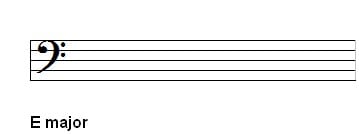
Triads: Answer 1
The key signature of E major contains four sharps, namely F#, C#, G# & D#. Place the triads on the stave as shown. Notice that the bass note (lowest note of the triad) relates to either I, IV or V of the key.
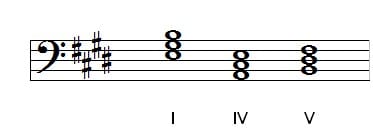
Triads: Question 2
Write the key signature followed by the three primary triads: tonic, subdominant and dominant. Identify the triads by writing I, IV or V below the chords.
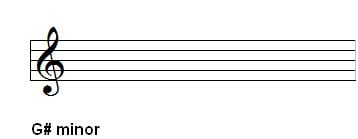
Triads: Answer 2
The key signature of G# minor contains five sharps, namely F#, C#, G# D# & A#. Place the triads on the stave as shown. Notice that the bass note (lowest note of the triad) relates to either I, IV or V of the key. Take note that in a minor key chord V will contain the leading note, in this case the note F#. This note is now F double sharp as it is the raised 7th in the minor scale.

Triads: Question 3
Write the key signature followed by the three primary triads: tonic, subdominant and dominant. Identify the triads by writing I, IV or V below the chords.
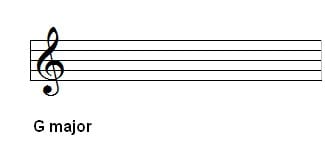
Triads: Answer 3
The key signature of G major contains one sharp, namely F#. Place the triads on the stave as shown. Notice that the bass note (lowest note of the triad) relates to either I, IV or V of the key.
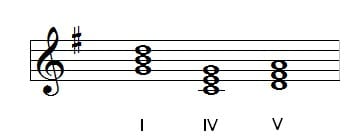
Triads: Question 4
Write the key signature followed by the three primary triads: tonic, subdominant and dominant. Identify the triads by writing I, IV or V below the chords.
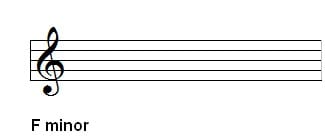
Triads: Answer 4
The key signature of F minor contains four flats, namely Bb, Eb, Ab & Db. Place the triads on the stave as shown. Notice that the bass note (lowest note of the triad) relates to either I, IV or V of the key. Take note that in a minor key chord V will contain the leading note, in this case the note Eb. This note is now E natural as it is the raised 7th in the minor scale.
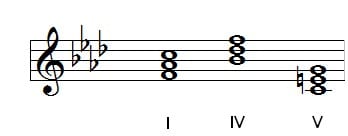
Triads: Question 5
Write the key signature followed by the three primary triads: tonic, subdominant and dominant. Identify the triads by writing I, IV or V below the chords.
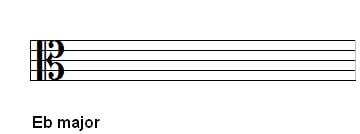
Triads: Answer 5
The key signature of Eb major contains three flats, namely Bb, Eb & Ab. Place the triads on the stave as shown. Notice that the bass note (lowest note of the triad) relates to either I, IV or V of the key.
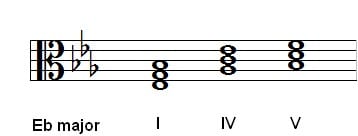
Triads: Question 6
Identify each triad by writing I, IV or V below the chord.
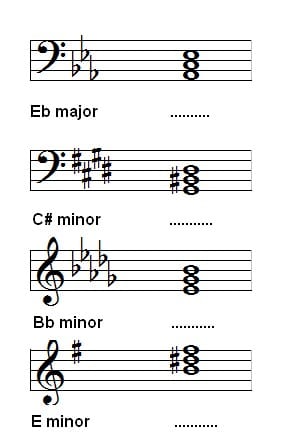
Triads: Answer 6
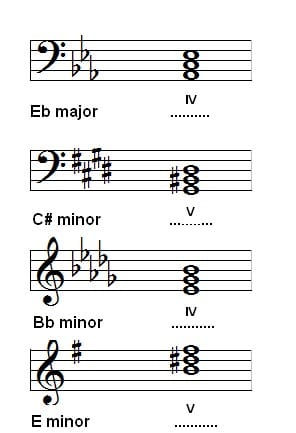
Triads: Question 7
Identify each triad by writing I, IV or V below the chord.

Triads: Answer 7
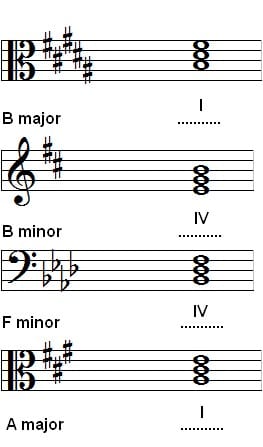
Triads: Question 8
Identify each triad by writing I, IV or V below the chord.
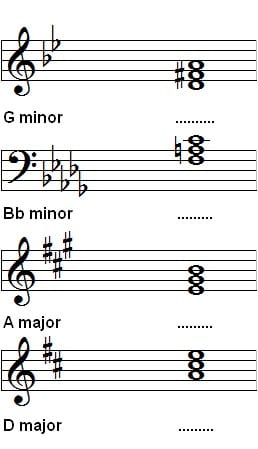
Triads: Answer 8
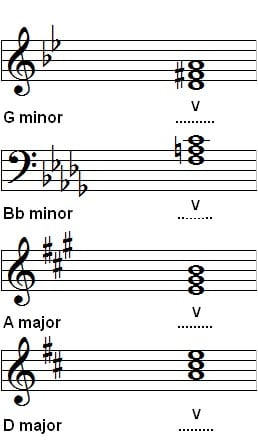
Triads: Question 9
Identify each triad by writing I, IV or V below the chord.
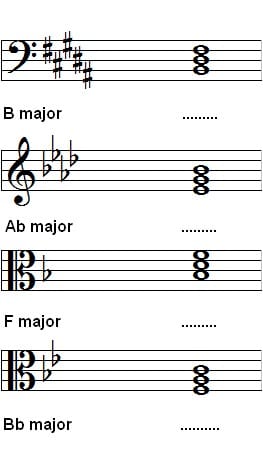
Triads: Answer 9

Triads: Question 10
In these exercises write the triad for each key. Do not use a key signature but put in any accidentals where they are needed.
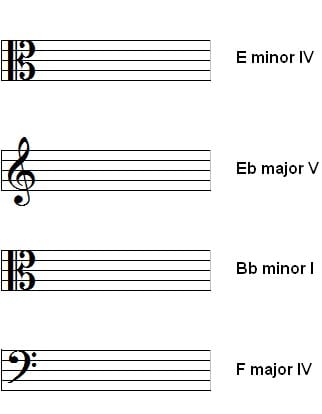
Triads: Answer 10
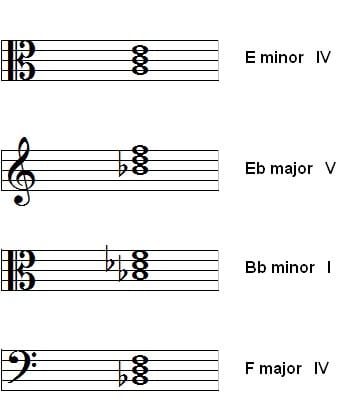
Triads: Question 11
In these exercises write the triad for each key. Do not use a key signature but put in any accidentals where they are needed.
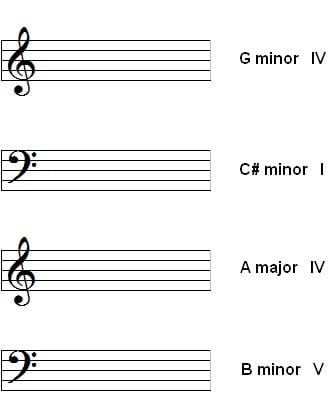
Triads: Answer 11

Triads: Question 12
In these exercises write the triad for each key. Do not use a key signature but put in any accidentals where they are needed.
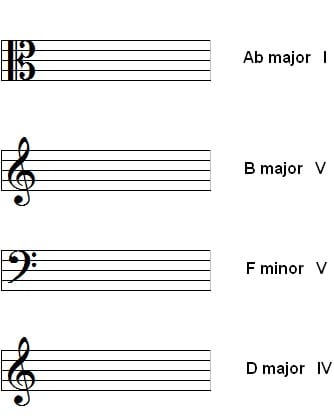
Triads: Answer 12

Triads: Question 13
Look at this extract and name the key. Identify the shaded chords by writing either I, IV or V below the chord.
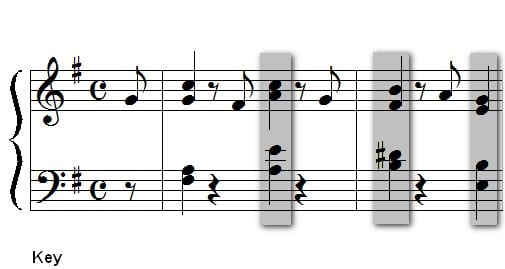
Triads: Answer 13
Analyzing this question:
The key is E minor – F# in the key signature and notice the D# (raised 7th note).
It may be useful to write the following chords to help with this answer.
| I | IV | V |
| B | E | F# |
| G | C | D# |
| E | A | B |
From this chart it is easier to find the required chords.

Triads: Question 14
Look at this extract and name the key. Identify the shaded chords by writing either I, IV or V below the chord.
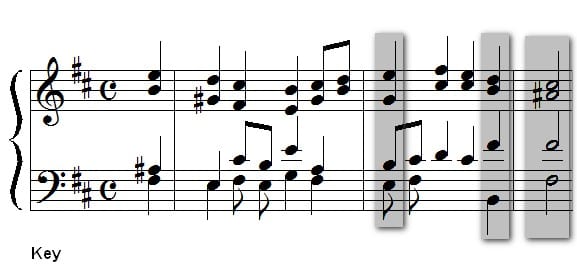
Triads: Answer 14
Analyzing this question:
The key is B minor – F# & C# in the key signature and notice the A# (raised 7th note).
It may be useful to write the following chords to help with this answer.
| I | IV | V |
| F# | B | C# |
| D | G | A# |
| B | E | F# |
From this chart it is easier to find the required chords.
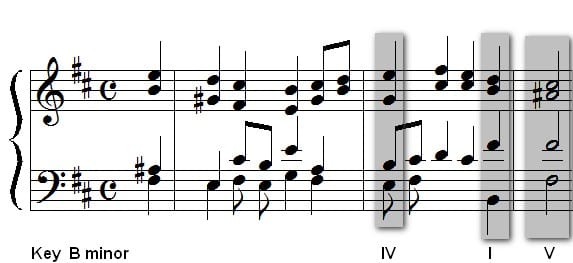
Triads: Question 15
Look at this extract and name the key. Identify the shaded chords by writing either I, IV or V below the chord.

Triads: Answer 15
Analyzing this question:
The key is Db major – Bb, Eb, Ab, Db & Gb in the key signature.
It may be useful to write the following chords to help with this answer.
| I | IV | V |
| Ab | Db | Eb |
| F | Bb | C |
| Db | Gb | Ab |
From this chart it is easier to find the required chords.
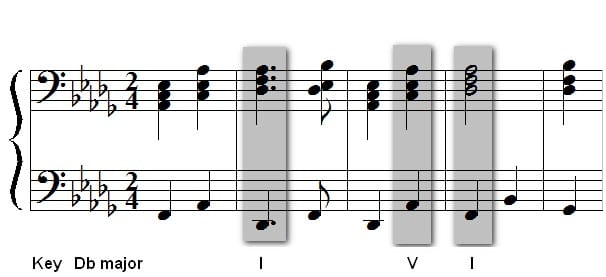
Triads: Question 16
Look at this extract and name the key. Identify the shaded chords by writing either I, IV or V below the chord.
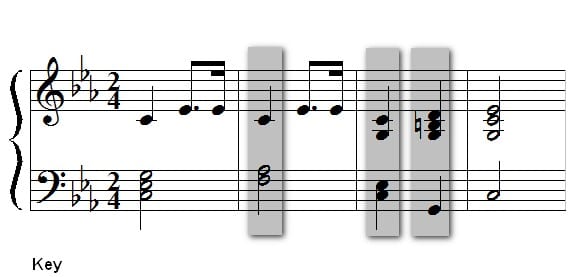
Triads: Answer 16
Analyzing this question:
The key is C minor – Bb, Eb & Ab in the key signature and notice the B natural (raised 7th note).
It may be useful to write the following chords to help with this answer.
| I | IV | V |
| G | C | D |
| Eb | Ab | B |
| C | F | G |
From this chart it is easier to find the required chords.
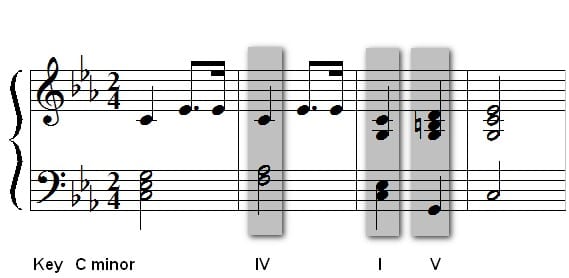
Triads: Question 17
Look at this extract and name the key. Identify the shaded chords by writing either I, IV or V below the chord.
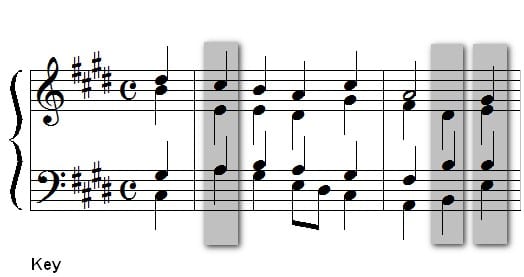
Triads: Answer 17
Analyzing this question:
The key is E major – F#, C#, G# & D# in the key signature.
It may be useful to write the following chords to help with this answer.
| I | IV | V |
| B | E | F# |
| G# | C# | D# |
| E | A | B |
From this chart it is easier to find the required chords.
